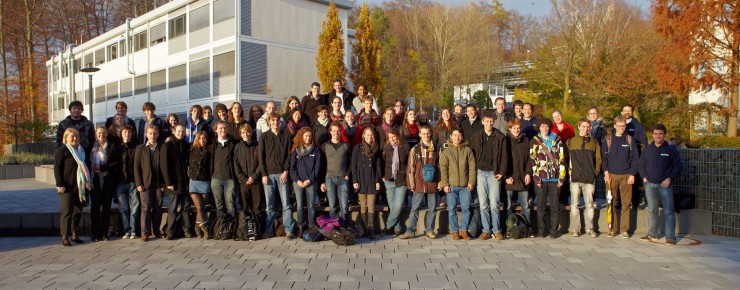Activities
Academic trip to Heidelberg Nov. 2011
In search for interdisciplinary research in a picturesque town
Science Honours Students at EMBL, Heidelberg, November 18th 2011
From 16th to 19th November, the Honours Students from the Faculty of Science of the University of Utrecht, were given the great opportunity to visit Heidelberg. It was the first ever excursion of this kind, organized in the context of the new Interdisciplinary Module that bring together all the Science Honours Students in Utrecht. Such an excursion will hopefully become a regular annual event of this programme. The purpose of our trip was not the beautiful city itself, but mainly the university and outstanding interdisciplinary research institutes in the area around Heidelberg. The trip was also meant to improve the understanding of interdisciplinarity among students from all the different disciplines of science that are included in our Faculty of Science Honours Programme. Notwithstanding the serious intentions, we also had a lot of fun in Germany. For instance, we were given free time to explore the beautiful old university town.
From 16th to 19th November, the Honours Students from the Faculty of Science of the University of Utrecht, were given the great opportunity to visit Heidelberg. It was the first ever excursion of this kind, organized in the context of the new Interdisciplinary Module that bring together all the Science Honours Students in Utrecht. Such an excursion will hopefully become a regular annual event of this programme. The purpose of our trip was not the beautiful city itself, but mainly the university and outstanding interdisciplinary research institutes in the area around Heidelberg. The trip was also meant to improve the understanding of interdisciplinarity among students from all the different disciplines of science that are included in our Faculty of Science Honours Programme. Notwithstanding the serious intentions, we also had a lot of fun in Germany. For instance, we were given free time to explore the beautiful old university town.
Without further ado, let me introduce you to the main dish of our visit: the institutes. On Thursday morning, we chose to either visit Heidelberg’s pharmacy museum or the Institute for Scientific Computing (IWR). In the former, located in the beautiful castle above the old town, we were given an insight in how pharmacy has evolved since medieval times, from the well-meant quackery of the old days to modern sophisticated medicine. At the IWR located on the university science campus, after the introduction by Prof. Dr. Hans Georg Bock, the IWR offered a balanced programme, which introduced us to various research that needed computers, such as car racing and ancient writings. During the afternoon, all of us were guided through the buildings of the German Center for Cancer Research (DKFZ) by the Dutch physician Dr. Bram Stieltjes and his research group colleagues. Here, interesting imaging techniques in medical research, such as Magnetic Resonance Imaging (MRI), were explained and shown to us. We even got to know how a melon looks from inside without cutting it open.
The next day, we went to the Physics Faculty of the University of Heidelberg, which has the most beautiful location in this beautiful town. The people there, Prof. Dr. Matthias Weidemüller, the director of the institute, and Priv-Doz. Klaus Reygers, told us what it is like to study the foundations of Nature, why the Higgs boson had not been found yet and how important super-cold atoms are for quantum computers. After the talks, we visited the labs, the houses of the theoretical physicists and their wonderful gardens in the Philosophenweg. After lunch, we went to the hills surrounding Heidelberg, to visit the European Molecular Biology Laboratories (EMBL). Contrary to the other institutes, EMBL did not amaze us with the actual research they are doing, but rather how they optimise the research environment, so that the researchers can focus on whatever interesting phenomenon they are looking for.
Certainly, this small introduction has made you curious as to what we actually did and heard in Heidelberg. Make sure you read the full articles on the different institutes by following the links, and don’t forget to read our conclusion!
Istvan Kleijn



Recent Comments